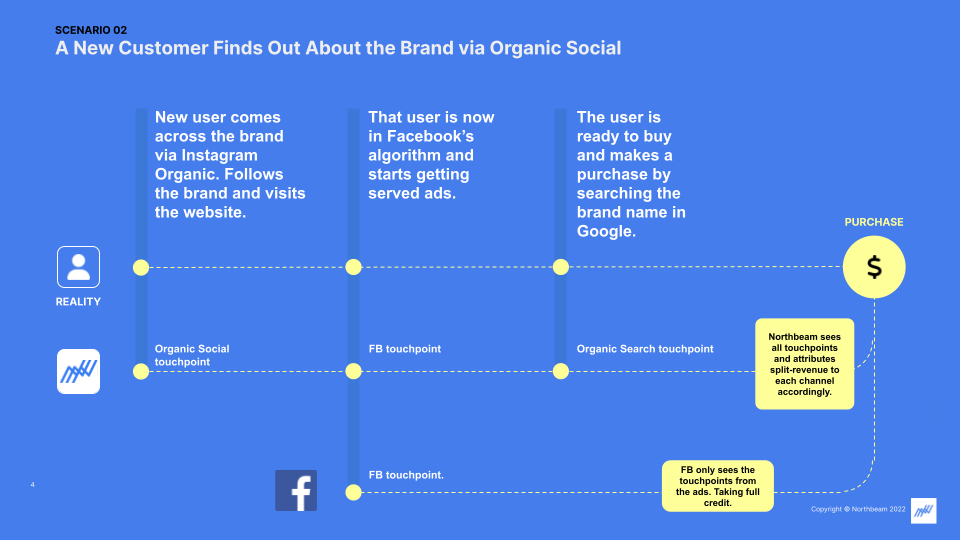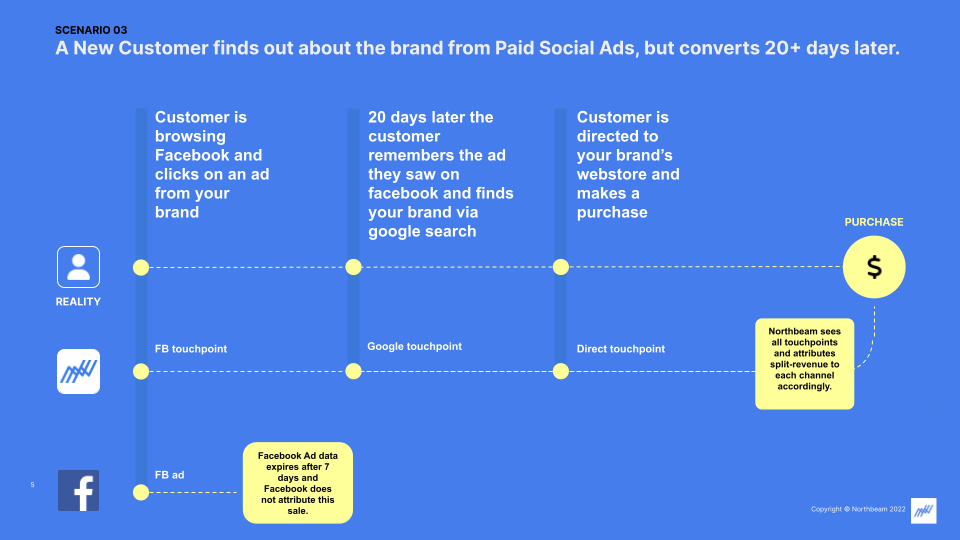Differences between Northbeam and in-platform reporting?
Learn about Northbeam's philosophy when it comes to attributing revenue appropriately to marketing touchpoints
Why is my Northbeam-reported data different than in-platform?
This video below talks about Facebook, but the same concept applies to ALL platforms.
One of the most common questions we get is: Why are the metrics I’m seeing in in-platform (Facebook, Google, TikTok, Pinterest, Klaviyo, etc.) different from the ones in Northbeam?
The short answer: They’re meant to be different. The two platforms are built on disparate tech stacks designed for separate goals, and our teams have contrasting philosophies when it comes to attributing revenue appropriately to marketing touchpoints. Therefore our calculations result in different metrics that we believe objectively portray what is actually going on in a customer’s journey before they ultimately convert.
In this article we’ll cover the differences between in-platform and Northbeam's reporting in detail and show some frequent scenarios that help illustrate the difference between reporting practices.
Differences in reported data are expected.
This concepts discussed apply ALL other platform-reported data (ex. Facebook, Google, TikTok, Pinterest, Klaviyo, etc)
Attribution Models and Windows
At a high level, Facebook only has a small grasp of a customer’s entire journey because they rely on third-party data that’s been severely hampered in a post iOS14 world. That’s why they’re limited to a 7-Day Click/1-Day View attribution window in addition to reporting lag. Since they only have access to data on their own marketing touchpoints, Facebook (and other ad platforms in general) tends to give full credit to any Facebook click or view that occurred on a customer path.
As a result, performance metrics tend to be overinflated which may give media buyers a false sense of security when doubling down on Facebook campaigns. You might be familiar with this phenomenon of spending more on a Facebook campaign with reported high ROAS, only to see little to no difference in conversions down the funnel.
Northbeam’s goal is to give you the most complete and actionable insights possible into your customer paths by assigning appropriate credit to any and all marketing touchpoints that occurred in their journey. We have our own proprietary pixel that utilizes first-party data so we can look at the entirety of a customer’s path, not just a partial view. This also allows us to offer you anywhere from a 1-Day to an infinite lifetime value attribution window. Beyond that, we have developed unique machine learning models that use multi-touch attribution to appropriately split revenue credit without inherent platform bias.
TIP:
Northbeam uses Attribution Models to analyze what parts of your marketing funnels and customer journeys drive the most impact and revenue. There are 6 Attribution Models available, including two unique Northbeam Multi-Touch Attribution Models. Read more about the models and how they work.
Common Example Scenarios
In this section we’ll cover 4 common situations that we see over and over again with a majority of our clients, and how Facebook would report on that scenario vs. how we would. Let’s start with a scenario where a customer clicks on no ads.
Scenario 1: Returning customer purchases again via Email without clicking on an ad
In this scenario, a returning customer encounters a trigger of some sort such as an upcoming event that they need to shop for. They continue their typical online behavior- occasionally checking Facebook and getting served ads for that brand/ product because that customer is already in Facebook’s ad ecosystem and is therefore more likely to click on ads. However, that customer only views those ads and does not actually click on any ads. Some time later, they click on a marketing email from your brand with a compelling offer (read our Campaign Starter Kit for more tips on how to craft compelling offers) and directly purchase on your website.

Northbeam treats this as three distinct touchpoints: a FB “View” touchpoint, an email touchpoint, and a direct touchpoint to the website for the ultimate conversion. Depending on the attribution model you’re using, we’ll assign credit appropriately to each of these three touchpoints. Facebook on the other hand only sees the “View” touchpoint that occurred first and gives full credit for the conversion to that touchpoint, resulting in skewed metrics.
Scenario 2: A New Customer Finds Out About the Brand via Organic Social & Search
If your brand has a strong organic social following or frequently leverages influencers, then you might drive lot of traffic to your website through viral social campaigns. Let’s say a user comes across your brand after seeing an Instagram post. They follow your brand and visit your website to get more information. That follow triggered Facebook to start serving them ads where they may or may not interact with them beyond views. Some time later, they realize they’re ready to buy and make a purchase after searching for the brand in Google.

Northbeam sees three touchpoints in this case: the initial organic social follow, the subsequent FB ad interactions (whether view or click), and the ultimate conversion after an organic search. Conversion and revenue credit is attributed to these 3 touchpoints depending on your preferences, but Facebook would only see the FB ad interactions and give that touchpoint full credit for this customer path.
Scenario 3: A New Customer interacts with your Paid Ads, but converts much later
Let’s say a customer is browsing Facebook and clicks on an ad from your brand. However, after this initial touchpoint they go dormant for an extended period of time (20+) days before remembering the ad they saw on Facebook. They search for your brand on Google, click on the website and directly purchase there.

Remember that Facebook only has a 7-Day Attribution Window, so in this case because the purchase falls outside of this initial period Facebook won’t attribute this sale at all and will actually miss it. Northbeam tracks the initial FB touchpoint indefinitely so we’ll also capture the organic search 20+ days later as well as the direct website visit. Being able to capture and track these touchpoints indefinitely is a big advantage of the Northbeam platform, and would explain why our numbers are different from Facebook’s.
Scenario 4: A New Customer interacts with multiple platforms before purchasing
What if a customer sees ads from multiple platforms before ultimately purchasing? In this scenario a customer is searching for a product and clicks on a Non-Branded Search Ad. Some time later, the user is targeted by Facebook and also clicks on an ad. Finally a few days later they’re ready to purchase and search for the brand in Google before converting directly on the website.

In this scenario, Google only sees their own touchpoints which is non-branded search and assigns that full credit for the conversion. Similarly Facebook only sees their ad touchpoint and assigns that full credit. Northbeam sees all 3 touchpoints, from the initial search all the way to conversion. Our multi-touch attribution models help you analyze which touchpoints drove the most impact from discovery to conversion.
Updated 6 months ago
